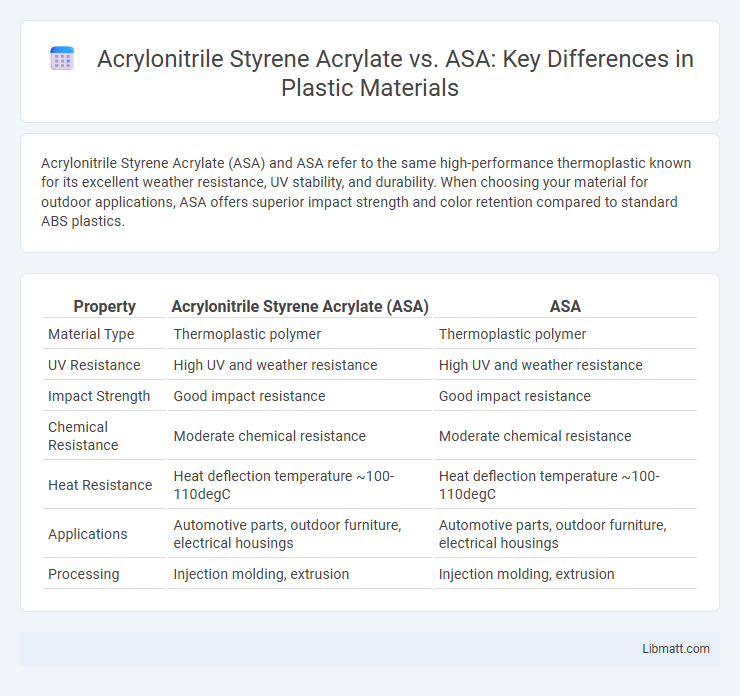Acrylonitrile Styrene Acrylate (ASA) and ASA refer to the same high-performance thermoplastic known for its excellent weather resistance, UV stability, and durability. When choosing your material for outdoor applications, ASA offers superior impact strength and color retention compared to standard ABS plastics.
Table of Comparison
| Property | Acrylonitrile Styrene Acrylate (ASA) | ASA |
|---|---|---|
| Material Type | Thermoplastic polymer | Thermoplastic polymer |
| UV Resistance | High UV and weather resistance | High UV and weather resistance |
| Impact Strength | Good impact resistance | Good impact resistance |
| Chemical Resistance | Moderate chemical resistance | Moderate chemical resistance |
| Heat Resistance | Heat deflection temperature ~100-110degC | Heat deflection temperature ~100-110degC |
| Applications | Automotive parts, outdoor furniture, electrical housings | Automotive parts, outdoor furniture, electrical housings |
| Processing | Injection molding, extrusion | Injection molding, extrusion |
Introduction to Acrylonitrile Styrene Acrylate (ASA)
Acrylonitrile Styrene Acrylate (ASA) is a thermoplastic polymer known for its exceptional weather resistance, making it ideal for outdoor applications. ASA offers high impact resistance, UV stability, and excellent mechanical properties, outperforming many other styrene-based plastics. Its chemical structure enables it to maintain color and structural integrity even under prolonged exposure to sunlight and harsh environmental conditions.
What is Acrylonitrile Styrene Acrylate (ASA)?
Acrylonitrile Styrene Acrylate (ASA) is a thermoplastic polymer known for its excellent weather resistance, impact strength, and UV stability, making it ideal for outdoor applications. It shares similarities with Acrylonitrile Butadiene Styrene (ABS) but offers superior resistance to sunlight and environmental stress. Your projects benefit from ASA's durability in harsh conditions, especially in automotive parts, outdoor equipment, and consumer goods.
Understanding ASA in Material Science
ASA, or Acrylonitrile Styrene Acrylate, is a thermoplastic polymer known for its excellent weather resistance, UV stability, and impact strength, making it ideal for outdoor applications. In material science, ASA's amorphous structure contributes to its superior durability compared to traditional ABS, particularly in exposure to sunlight and harsh environments. Its chemical composition, which includes acrylate rubber, enhances flexibility and resistance to heat, reinforcing its role in automotive and construction industries.
Key Properties of ASA Plastics
ASA plastics exhibit excellent weather resistance, maintaining color and mechanical properties under prolonged UV exposure and harsh environmental conditions. Their high impact strength and superior chemical resistance make them suitable for automotive parts and outdoor applications. ASA also offers good thermal stability and dimensional consistency, enabling reliable performance in demanding manufacturing processes.
Common Applications of ASA Materials
ASA materials are widely used in automotive components, outdoor furniture, and sports equipment due to their excellent weather resistance and UV stability. They are ideal for applications requiring high impact strength and color retention in harsh outdoor environments. ASA's superior resistance to chemicals and environmental stress cracking makes it suitable for electric enclosures and construction materials.
Advantages of ASA over Other Plastics
ASA (Acrylonitrile Styrene Acrylate) offers superior weather resistance and UV stability compared to other plastics like ABS and polycarbonate, making it ideal for outdoor applications. Its excellent mechanical properties, such as impact resistance and rigidity, ensure durability and long-term performance in harsh environments. You benefit from ASA's color retention and resistance to chemical exposure, which reduce maintenance and replacement costs over time.
Limitations and Drawbacks of ASA
ASA (Acrylonitrile Styrene Acrylate) exhibits excellent weather resistance and impact strength but faces limitations such as higher production costs and lower heat resistance compared to materials like ABS or Polycarbonate. Its chemical resistance is moderate, making it less suitable for prolonged exposure to solvents or strong acids. ASA also tends to have less flexibility and can be more brittle in cold temperatures, restricting its applications in certain environments.
Comparing ASA to Acrylonitrile Butadiene Styrene (ABS)
ASA offers superior weather resistance and UV stability compared to ABS, making it ideal for outdoor applications exposed to sunlight and harsh conditions. Your projects benefit from ASA's enhanced color retention and structural durability, while ABS tends to degrade faster when exposed to environmental elements. Both materials share similar mechanical properties, but ASA's improved longevity and resistance to environmental stress cracking set it apart for long-term outdoor use.
ASA vs. Polycarbonate: Performance Comparison
ASA (Acrylonitrile Styrene Acrylate) offers superior weather resistance and UV stability compared to Polycarbonate, making it ideal for outdoor applications exposed to harsh environments. Polycarbonate excels in impact strength and transparency, providing better toughness and optical clarity for protective gear and glazing applications. While ASA provides improved chemical resistance and color retention, Polycarbonate delivers higher heat resistance and dimensional stability under mechanical stress.
Environmental Impact and Sustainability of ASA Products
ASA (Acrylonitrile Styrene Acrylate) exhibits a relatively lower environmental impact compared to other plastics due to its durability and weather resistance, which extend product lifespan and reduce waste. Its recyclability contributes to sustainability efforts, although ASA production involves petrochemical processes that pose environmental challenges. You can enhance your product's eco-friendliness by choosing ASA variants formulated with recycled content or designed for efficient recycling streams.
Acrylonitrile Styrene Acrylate vs ASA Infographic

 libmatt.com
libmatt.com